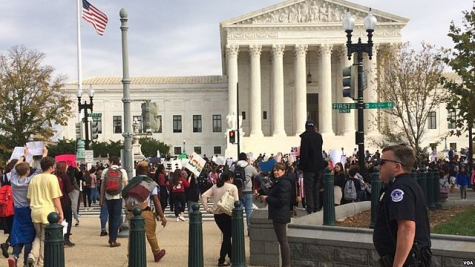Iowa caucus kicks off presidential race
February 10, 2016
The race for the White House officially began on Feb.1 with more than 351,000 Iowans participating in the Iowa caucus this year, a record turnout. After six hours of voting, Ted Cruz emerged victorious in the Republican Party with 28 percent, Donald Trump came second and Marco Rubio was a close third. In the Democratic Party, Hillary Clinton won by less than half a percent, with Bernie Sanders came in second, and Martin O’Malley in third with less than one percent.
As for why the voting ended up the way it did, senior Illiyeen Khan speculates that the results of the Iowa caucus was based on Iowa’s demographics.
“There’s a large evangelical population in Iowa, and that’s why Ted Cruz got more votes over Trump and Rubio,” Khan said. “It was obvious that Hilary Clinton was going to win Iowa either way, as she has already had previous support in the state, versus Bernie Sanders being a newcomer.”
Several presidential candidates dropped out of the race following the Iowa caucuses after disappointing finishes. In the past week, Arkansas’ former governor Mike Huckabee, Senator Paul Rand, former Senator Rick Santorum, and Maryland’s former governor Martin O’Malley suspended their campaigns.
There has been quite a lot of speculation on the accuracy of the Iowa caucuses. A day after the results were released, Trump called for a new caucus in Iowa, accusing Ted Cruz of fraud. In a tweet, he pointed out that the Cruz campaign had falsely told voters that Ben Carson planned to drop out of the presidential race. Trump wrote that Cruz “illegally” won the caucus, but later deleted his comment on Twitter. Although Cruz’s campaign has apologized to Ben Carson, stating that there was a misunderstanding, another caucus will not be staged.
The Iowa Democratic Party discovered errors in their results from five precincts, but it did not change the overall results. Even with the revised vote, it’s still unclear as to who won the popular vote. As per tradition, the Democratic Party officials declined to release the raw vote numbers.
Freshman Trent Mueller points out that that after months of building up campaigns, presidential candidates finally get to see some results to indicate their success.
“It suggests what’s to come,” Mueller said. “It tells some candidates that aren’t doing as well to drop out, and it tells the candidates who their main competitors are.”
During the Iowa caucuses, the Democratic Party had to use coin tosses between Hillary Clinton and Bernie Sanders to break ties in precincts that award an odd number of delegates. As a result, Hillary Clinton won five delegates, two more than Sanders. However, even though the final results of caucus were the closest ever in the past 40 years of the Iowa caucus, the results of the coin toss did not give Clinton that half a percent advantage over Sanders.
Much of the confusion over the results of the Iowa caucuses rides on the fact that the Democrats and the Republicans run their caucuses in different ways. Each Republican casts their binding vote in a secret ballot. Then, each campaign gets a chance to convince any unsure voters before the voters place their vote. The raw totals of the votes are tallied by officials and sent to Iowa GOP officials to keep a running count.
The Democrats vote with a different method involving precincts. The first thing attendees do is declare their preference for a candidate. Those who can not make up their mind join a group known as “uncommitted.” Once everyone is organized into groups, the Democratic Party officials rule whether or not each group is viable based on whether or not they clear a certain threshold based on their percentage. After their first-round votes are tallied, those that were in a group that was considered as not viable have the chance to position themselves in place with another candidate that has be ruled as viable. After that, a second count will be taken.
From the results of the Iowa caucus in 2008, none of the top three Republicans were chosen as a presidential candidate by the Republican Party. Social Studies teacher Steven Buenning brings into question the true relevance of the Iowa caucuses, and whether or not they yield accurate results.
“It’s not indicative at all of how the nominated procedure is going to play out. Iowa is not representative of the country as a whole, it’s not a very diverse state,” Buenning said. “It’s a state that gets a lot of attention because they go to great lengths to be the first sounding board for candidates running for president, and the results from the Iowa caucuses are not to be reflective of anything in particular.”
A controversial aspect of the voting process during the Iowa caucuses is that the Democratic caucuses lacks a private ballot, whereas the Republican caucuses do have a private ballot. This means that while Republicans have the power to vote for whoever they want without anyone else knowing, the Democrats need be sure of their decision and may be pressured into choosing a candidate that they do not truly believe in.
Social studies teacher Kevin Palmer believes that the idea of a caucus is good in principle, but advocates for a revisit to the system used in the Iowa caucus to ensure accurate results in the future.
“Though the Republicans announce the total votes per presidential candidate. The Democrats announce their results by precinct—or voting area—and no one understands that system. There’s obviously some problems. The system is a bit archaic in that regard,” Palmer said.





